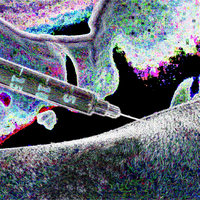| Chloral hydrate | |
|---|---|
| Molecular structure via molpic based on CDK |
| Physical properties [] | |
|---|---|
| Molecular mass | 165.40 g/mol [1] |
| Density | 1.9081 at 68 °F (NTP, 1992) - Denser than water; will sink g/cm3 [1] |
| Appearance | COLORLESS OR WHITE CRYSTALS [1] |
| Odor | Aromatic, penetrating and slightly acrid odor [1] |
| Taste | Slightly bitter, caustic taste [1] |
| Melting point | 135 ° [1] |
| Boiling point | 207.5 ° [1] |
| Decomposition | When heated to decomposition it emits toxic fumes of /hydrogen chloride/. [1] |
| Solubility | greater than or equal to 10 mg/mL at 68.9 °F (NTP, 1992) [1] |
| Predicted LogP | 1 [1] |
| Structural Identifiers [] | |
|---|---|
| Molecular formula | C2H3Cl3O2 [1] |
| IUPAC name | 2,2,2-trichloroethane-1,1-diol [1] |
| SMILES | C(C(Cl)(Cl)Cl)(O)O [1] |
| InChI | InChI=1S/C2H3Cl3O2/c3-2(4,5)1(6)7/h1,6-7H [1] |
| InChIKey | RNFNDJAIBTYOQL-UHFFFAOYSA-N [1] |
Chloral hydrate
(Redirected from Chloral hydrate)Chloral hydrate (also known as 2,2,2-Trichloroethane-1,1-diol, Noctec, Trichloroacetaldehyde hydrate, Tosyl, Chloral monohydrate, Chloraldurat, Chloralhydrate, Phaldrone, Nycoton or Chloradorm) is a depressant substance of the alcohol class.
Chemistry
Stereochemistry []
Chloral hydrate is a achiral mixture
See also []
External links []
References []
National Center for Biotechnology Information. PubChem Compound Summary for CID 2707, Chloral hydrate. Accessed July 19, 2025. https://pubchem.ncbi.nlm.nih.gov/compound/2707
U.S. Food and Drug Administration; National Center for Advancing Translational Sciences. Chloral hydrate. UNII: 418M5916WG. Global Substance Registration System. Accessed July 19, 2025. https://gsrs.ncats.nih.gov/ginas/app/beta/substances/418M5916WG
 Anodyne
Anodyne